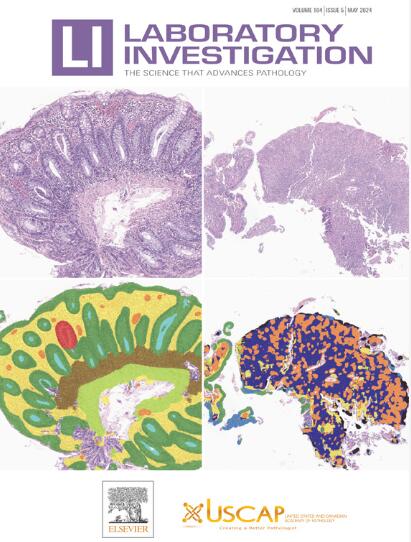衰老上皮细胞在成釉细胞瘤中起侵袭性生长驱动作用。
IF 4.2
2区 医学
Q1 MEDICINE, RESEARCH & EXPERIMENTAL
引用次数: 0
摘要
细胞衰老及其相关微环境在肿瘤的发生和发展中起着关键作用。虽然成釉细胞瘤(AM)被归类为良性肿瘤,但它具有局部侵袭性和高复发率的特点。在这项研究中,我们使用衰老相关的β-半乳糖苷酶染色确定了一个独特的衰老上皮细胞群,并探讨了该亚群在AM进展中的作用。CellChat工具被用于绘制细胞间通信网络,揭示了这种衰老细胞簇促进邻近细胞的干性,并驱动血管生成和破骨细胞生成,随后通过一系列体外实验证实了这一点。此外,从这些衰老细胞中提取的条件培养基显著促进了患者来源的类器官的肿瘤生长。临床数据进一步表明,AM患者细胞衰老水平升高与肿瘤侵袭性增强和预后不良密切相关。总之,我们的研究结果表明,针对这一特定的衰老上皮细胞亚群可能为AM治疗提供一种新的治疗方法,可能会降低肿瘤的侵袭性和复发。本文章由计算机程序翻译,如有差异,请以英文原文为准。
Senescent Epithelial Cells Serve as Invasive Growth Drivers in Ameloblastoma
Cellular senescence and its associated microenvironment play a pivotal role in tumor initiation and progression. Although ameloblastoma (AM) is classified as a benign tumor, it is characterized by local invasiveness and a high recurrence rate. In this study, we identified a distinct population of senescent epithelial cells using senescence-associated β-galactosidase staining and explored the role of this subpopulation in AM progression. The CellChat tool was utilized to map intercellular communication networks, revealing that this senescent cell cluster promotes stemness in neighboring cells and drives angiogenesis and osteoclastogenesis, which was subsequently confirmed by a series of in vitro experiments. Moreover, conditioned medium from these senescent cells significantly enhanced tumor growth in patient-derived organoids. Clinical data further demonstrated that elevated levels of cellular senescence were strongly associated with greater tumor invasiveness and poorer prognosis in AM patients. In conclusion, our findings suggest that targeting this specific subset of senescent epithelial cells may offer a novel therapeutic approach for AM management, potentially reducing tumor aggressiveness and recurrence.
求助全文
通过发布文献求助,成功后即可免费获取论文全文。
去求助
来源期刊

Laboratory Investigation
医学-病理学
CiteScore
8.30
自引率
0.00%
发文量
125
审稿时长
2 months
期刊介绍:
Laboratory Investigation is an international journal owned by the United States and Canadian Academy of Pathology. Laboratory Investigation offers prompt publication of high-quality original research in all biomedical disciplines relating to the understanding of human disease and the application of new methods to the diagnosis of disease. Both human and experimental studies are welcome.
 求助内容:
求助内容: 应助结果提醒方式:
应助结果提醒方式:


